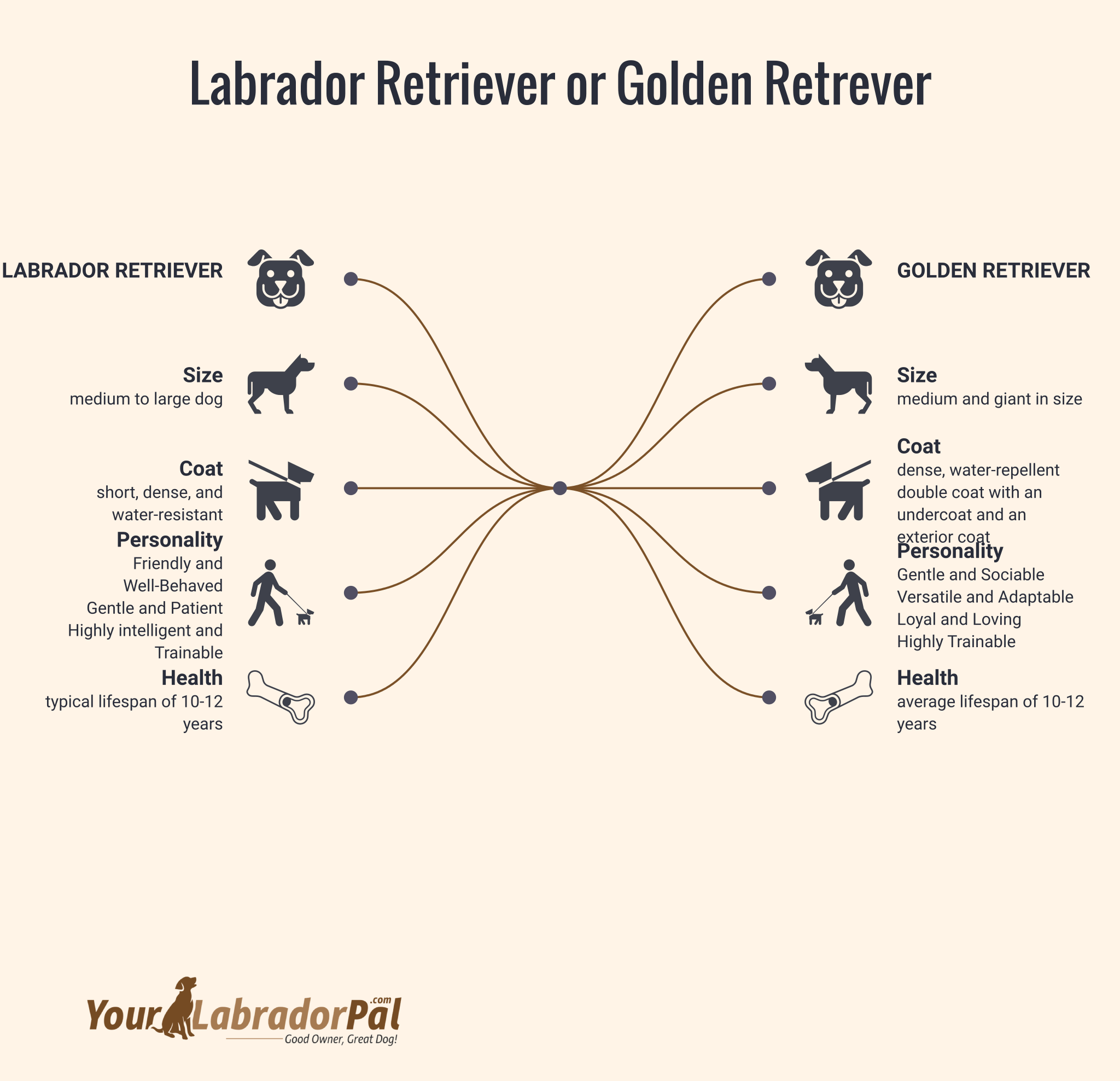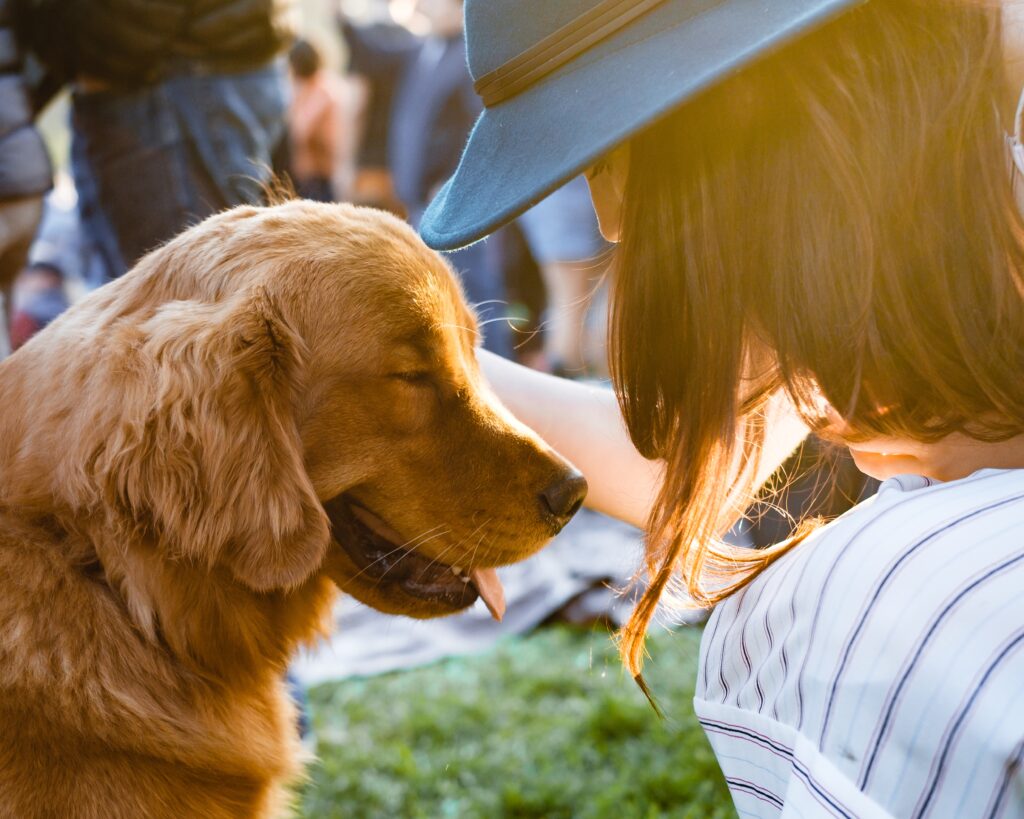Labrador Retriever or Golden Retriever: The Furfect Buddy
Few breeds can compare to the charm, loyalty, and adaptability of the Labrador Retriever and the Golden Retriever as canine companions. These two well-liked breeds have won over dog lovers worldwide with their amiable personalities, intelligence, and adaptability. The Labrador Retriever or Golden Retriever frequently tops the list whether you’re an active person looking for a devoted companion for outdoor adventures or a family looking for a peaceful and friendly pet.
This post will examine the traits, temperaments, and distinctive aspects of these cherished breeds to help you decide which would be the ideal companion for you and your way of life. So, let’s explore the wonderful world of Labrador Retrievers and Golden Retrievers and discover which breed best fits your preferences and needs.
Labrador Retriever or Golden Retriever: The Characteristics of Labs
Labs, also known as Labrador Retrievers, are large to medium-sized dogs with a strong physique. In order for us to have a deeper understanding which breed is better, the Labrador Retriever or Golden Retriever, let’s take a look at the personality of the Labs first. The following list of Labrador Retriever physical traits includes:
🐾Size
Labrador Retrievers often range in size from medium to large. Adult males typically weigh 65 to 80 pounds (29 to 36 kilograms), whereas adult females often weigh 55 to 70 pounds (25 to 32 kilograms), which is a little less. It’s important to keep in mind, though, that each Lab may have a different size.
🐾Height
Adult male labs measure between 21.5 and 24.5 inches (55 to 62 centimeters) tall at the shoulder, while adult females are often a little shorter, measuring between 21 and 23.5 inches (53 to 60 cm). Their physique is strong and muscular, with a deep chest and a large, powerful head. Labs have an athletic and durable physical structure thanks to its balance.
🐾Coat
The double coat on Labs is short, dense, and water-resistant. They are more weather-resistant because of their coat, which also makes swimming more comfortable. There are three distinct coat colors for Labrador Retrievers – yellow, black, and chocolate. Within each color group, the coat colors can range from light to dark tones.
Their characteristic “otter” tail, which is thick at the base and tapered toward the tip, is what makes them so recognizable. For Labs, their tail is a valuable tool that helps with swimming. They have a short, dense, water-resistant double coat. A short, dense, and water-resistant double coat on Labrador Retrievers helps to protect them from the elements.
🐕Coat Type:
The Labrador Retriever has an undercoat that is thick and insulating, with a short, straight topcoat. They are protected and kept warm by this double coat.
🐕Coat Colors:
The Labrador Retriever breed standard identifies three primary coat colors: yellow, black, and chocolate. Yellow can range from cream to deep fox red, while chocolate Labs have a light to dark chocolate coat, with variations within each category.
🐕Coat Upkeep:
Labrador Retrievers require minimal upkeep, brushing their short hair to prevent shedding, and bathing occasionally to maintain a clean, healthy coat
🐕Water-Resistant:
Labradors naturally possess a water-resistant coat that aids in defending them when they are in the water. Their thick, oily coating serves as a barrier, stopping excessive water absorption and enhancing their comfort while swimming.
Size and breed criteria may vary among Labs; proper nutrition, exercise, and care are crucial for their wellbeing.
🐾Labs Personality
Labradors are renowned for their friendly and outgoing personalities. It is commonly known that Labrador Retrievers have gregarious, amiable attitudes. Other than that, here are some of their temperament’s salient traits:
🐕Friendly and Well-Behaved:
Labradors are known for being approachable and friendly. They frequently have a kindly and warm demeanor by nature, which makes them gregarious and hospitable to both people and other animals. They make wonderful family pets and friends because of their amiable temperament.
🐕Gentle and Patient:
Labs are normally calm and patient, which makes them suitable for households with youngsters as well as for families. They frequently exhibit a tolerant and understanding demeanor, which makes them great playmates for children. To protect the security and welfare of both parties, it is crucial to continuously monitor interactions between canines and young children.
Labrador Retrievers are well recognized for their friendly personalities and dedication to their human companions. They like being a part of their family’s daily activities and develop close relationships with them. In order to express their love and loyalty, Labs frequently seek out physical contact with their owners, such as leaning on them or huddling up next to them.
Labs typically have an easygoing and adaptable attitude, which makes them suitable for a variety of living circumstances. If they get the proper exercise, mental stimulation, and care, they may adapt to a variety of locations, including a suburban house, a rural location, or even an apartment.
Labrador Retrievers are amiable, good-natured dogs with diverse temperaments. To develop well-rounded companionship, early socialization, training, and positive reinforcement are crucial. They are renowned for their friendliness, gentleness, and compatibility with families and children.
🐕Highly intelligent and Trainable:
Because of their intelligence and trainability, Labrador Retrievers are well-liked in a variety of employment roles.
One of the smartest canine breeds is the Labrador, according to experts. They are quick learners and have a keen brain. They can effectively comprehend and obey instructions, deal with issues, and learn new duties thanks to their intelligence.
Due to their intellect, desire to please, and cooperative temperament, Labs are extremely trainable canines. Positive reinforcement training techniques, like rewards, compliments, and treats, are effective with them. They are ideal for a variety of training objectives due to their openness to learning and capacity for memory.
Labrador Retrievers are popular choices for assistance dogs because of their intelligence, trainability, and outgoing personalities. They can receive special training to help people with a variety of needs, such as those related to mobility, vision, or other needs. Service dogs are capable of carrying out tasks like object retrieval, door opening, balance support, and medical condition detection.
Labrador Retrievers are excellent search and rescue canines. They are excellent in finding missing people and identifying specific odors thanks to their intelligence, great sense of smell, and endurance. They are frequently used in search and rescue activities, such as discovering survivors in disaster zones or tracking down lost people in remote places.
Labrador Retrievers are trained assistance dogs for people with disabilities, providing stability and support through tasks like opening doors and retrieving objects. Their intelligence and flexibility make them valuable allies.
Labrador Retrievers are intelligent and trainable for various professions, but require specialized programs and qualified trainers for service, search, rescue, and assistance work. Proper training and socialization are crucial for their success.
🐕Strong Retrieving instincts:
The retrieving instinct in Labrador Retrievers is strong, and they are recognized for enjoying games, swimming, and fetching.
Due to their history as working dogs, Labradors have a strong innate sense for retrieving. They make great partners for fetching games whether it’s a ball, a frisbee, or even a stick thanks to this inclination. Their behavior is deeply ingrained with the impulse to retrieve and carry objects in their mouths.
Swimming
Labradors frequently swim with enthusiasm. They enjoy being in the water because of their webbed toes, which help them swim, and water-resistant coat. Swimming is a great form of low-impact exercise for Labs since it keeps their bodies healthy, and their minds engaged.
Playing Games and Fetching
Labs love to play games that require them to fetch things. Playing fetch is a favorite pastime for Lab owners because it gives the dogs a chance to use their innate retrieving instincts while also getting them some physical and mental stimulation. Playing interactive games like hide-and-seek or using puzzle toys will also keep their minds occupied and prevent them from getting bored.
🐾Labradors Exercise Requirements
Labrador Retrievers need to be regularly exercised to maintain their physical and mental health because they are active dogs. Daily exercise sessions, such as brisk walks, jogging, playing in a safe, open space, or taking part in dog sports like agility or obedience training are beneficial to them. Labs require activities that engage their body and mind because they need outlets for their energy.
Lack of exercise and mental stimulation can lead to Labrador Retriever weight gain and destructive habits. Regular exercise and mental stimulation, such as swimming and fetching, will keep them happy and content.
🐾Labrador Retriever or Golden Retriever: The Health of Labrador Retrievers
Labrador Retrievers have a typical lifespan of 10-12 years, with individual lifespans influenced by genetics, health, nutrition, exercise, and medical care. The following are some of the breed’s typical health issues:
🦴Hip and Elbow Dysplasia:
Labradors face hip and elbow dysplasia, affecting joint growth and function, causing discomfort, lameness, and mobility issues. Responsible breeders regularly check dogs for these disorders.
🦴Obesity:
Labs may gain weight due to excessive appetites, requiring balanced diet, exercise, and portion control for overall health and preventing health complications like joint issues and diabetes.
🦴Eye problems:
Labrador Retrievers may suffer from progressive retinal atrophy, cataracts, and dysplasia; routine eye exams can identify and treat these issues.
🦴Other Health Issues:
Labradors may be at risk of health problems like exercise-induced collapse, skin disorders, ear infections, and cancers. Reducing these risks requires responsible breeding, regular veterinary examinations, and a healthy lifestyle.
Owners should be aware of Labrador Retriever health issues and take preventative measures to ensure their happiness and wellbeing. Regular veterinary care, balanced food, exercise, and a healthy weight are essential.
Ethical breeders prioritize Labrador Retrievers’ health through stock selection, health testing, exercise, diet, grooming, and veterinarian care.
Labrador Retriever or Golden Retriever: Characteristics of Golden Retriever
knowing the characteristics of the Goldens is another factor to identify which between the Labrador Retriever or Golden Retriever is better. Golden Retrievers are medium to large-sized dogs. In fact, Golden Retrievers are well-muscled than the Labradors. These are a few of the physical traits of Goldens:
🐾Size
Golden Retrievers are normally between medium and giant in size. Adult males typically weigh 65 to 75 pounds (29 to 34 kilograms), whereas adult females often weigh 55 to 65 pounds (25 to 29 kilograms), which is a little less. However, size might differ amongst different Golden Retrievers.
🐾Height
Mature male Golden Retrievers stand at a shoulder height of about 21.5 to 24 inches (55 to 61 centimeters), whereas mature females are often a little shorter, measuring between 20 and 22.5 inches (51 to 57 centimeters) at the shoulder.
🐾Build
With a strong frame and a broad chest, they have a well-muscled, balanced build. Due to their adaptability and athletic build, Golden Retrievers have a distinctive appearance.
🐾Tail
The unique tail of Golden Retrievers is thick at the base and taper toward the tip. One of their distinguishing characteristics is the way they frequently wag their tails.
🐾Coat
A dense, water-repellent double coat with an undercoat and an exterior coat is present on Golden Retrievers. Golden retrievers have a thick, double-coated coat that repels water. Their undercoat is soft and insulating, while their outside coat is thick, wavy, and shiny. The breed gets its name from the numerous colours of gold that make up its coat. The tints might range from light golden to medium golden to dark golden.
Golden Retrievers require regular brushing to maintain healthy coats, removing stray hair, preventing matting, and preserving natural sheen. They shed moderately year-round, with heavier sheds during seasonal changes. Golden Retrievers excel in water-related activities due to their dense outer coat, making them great partners.
Regular maintenance is essential for the Golden Retriever’s coat, ensuring health and beauty through grooming appointments and inspections.
🐕Coat Color:
Golden Retriever breed’s distinctive coat color varies from light cream to deep rich gold tones, with deviations possible within this spectrum.
🐾Goldens Personality
Golden Retrievers are known for their friendly, intelligent, and eager-to-please personalities. They are renowned for having outgoing, perceptive, and please-me personalities. They are known for being great family pets and therapy dogs for the following reasons:
🐕Gentle and Sociable:
Golden Retrievers are approachable, kind, and friendly, making them ideal for families and children. They are intelligent dogs with a quick learning and eagerness to please nature, making them highly trainable and responsive to positive reinforcement techniques. Golden Retrievers are known for their tolerant and patient nature, making them ideal for therapy work, requiring composure and patience in various settings.
🐕Versatile and Adaptable:
Golden Retrievers excel in various living environments, possessing diverse skills and abilities, making them suitable for diverse families and lifestyles.
🐕Loyal and Loving:
Golden Retrievers are beloved family pets due to their loving temperament and dedication to family activities. These dogs are beloved family pets and therapy dogs due to their loving, smart, and patient nature, making them excellent companions.
🐕Highly Trainable:
Golden Retrievers are highly trainable and versatile dogs that excel in various activities and roles. Here’s more information about their trainability and capabilities:
Trainability
Golden Retrievers excel in intelligence, learning, and obedience, making them popular in dog sports and obedience training due to their natural abilities.
Obedience
Golden Retrievers excel in obedience training, excelling in commands and exercises due to their intelligence and desire for pleasure. Aside from that, they also excel in agility training due to their athleticism, stamina, intelligence, and cooperation with handlers, making them ideal candidates for competitions.
Dog Sports
Golden Retrievers excel in various dog sports like track, flyball, dock diving, and rally obedience due to their trainability and versatility. They also excel as assistance dogs for people with disabilities due to their intelligence, kindness, and adaptability, making them successful in various tasks.
Training Golden Retrievers for specific jobs requires specialized programs and qualified trainers. Their individual temperament and aptitude determine their suitability for various roles. With their trainability, intelligence, and adaptability, they excel in obedience, agility, and service work. They thrive in environments where they can use their skills, challenge their minds, and form strong relationships with handlers.
🐕Natural inclination for Water and Retrieving:
Due to their inherent affinity for water and retrieving, Golden Retrievers enjoy outdoor sports like swimming and fetch as well as other outdoor activities. More details regarding their affinity for the water and preferred pastimes are provided below:
Love of Water
Golden Retrievers are naturally drawn to the water. They can comfortably engage in watersports thanks to their thick, double coat that repels water and their webbed feet. They adore swimming and having fun in the water, and it is common to see them splashing around in lakes, rivers, or the ocean.
Swimming
Golden Retrievers have great swimming abilities. They excel in the water because they enjoy it and because swimming comes naturally to them. They enjoy swimming because it is both enjoyable and a terrific kind of exercise that helps them cool off, builds muscle, and offers a low-impact workout.
Playing Fetch
Golden Retrievers are excellent retrievers and adore the game of fetch. They take great pleasure in following and catching objects thrown for them, whether it’s a ball, a frisbee, or anything else. They are able to engage in this activity while still getting exercise and cerebral stimulation.
Golden Retrievers love to go on outdoor adventures. They enjoy going on hikes, visiting nature paths, and going on outdoor adventures with their owners. This breed thrives on activities that give them the chance to burn off energy, explore new scents, and exercise.
The love of water and retrieving activities shared by Golden Retrievers should be enjoyed responsibly. It’s crucial to give them a secure atmosphere when swimming, to keep an eye on them when they’re close to open water, and to take into account their swimming prowess. Make sure the place is safe and risk-free before starting a game of fetch.
Playing fetch, spending time in the water, and going on outdoor adventures are all excellent methods to keep Golden Retrievers active and cognitively engaged. They are given the activity and intellectual stimulation they require for a happy and satisfying existence through these activities, which also appeal to their natural tendencies.
Outdoor Adventures
Golden Retrievers enjoy outdoor adventures like hiking, exploring trails, and accompanying owners, requiring energy, scents, and physical exercise. Retrievers enjoy water activities safely; provide a safe environment, supervise near water, and consider abilities when swimming and fetching. Golden Retrievers benefit from water activities, fetch, and outdoor adventures for physical and mental stimulation, promoting happiness and fulfillment.
🐾Labrador Retriever or Golden Retriever: The Health of Golden Retrievers
Golden Retrievers have an average lifespan of 10-12 years, with factors like genetics, health, nutrition, exercise, and medical care affecting lifespans. They may also be susceptible to health issues.
🦴Hip dysplasia:
Golden Retrievers may develop hip dysplasia, causing joint instability; regular veterinary examinations and ethical breeding techniques can reduce risk.
🦴Elbow Dysplasia:
Golden Retrievers may be predisposed to elbow dysplasia, an orthopedic issue causing pain, lameness, and arthritis. Reducing elbow dysplasia through safe breeding and veterinary checkups.
🦴Cancer:
Golden Retrievers are more susceptible to developing cancers like hemangiosarcoma, lymphoma, and mast cell tumors; early screenings and vet exams aid diagnosis and treatment.
🦴Heart Issues:
Golden Retrievers may be susceptible to DCM and SAS heart problems; routine assessments and screenings help manage them.
Golden Retrievers may have health issues, but not all breeds have them. To promote their well-being, responsible breeding, regular veterinarian examinations, balanced food, exercise, and a healthy weight are essential. Choose trustworthy breeders who prioritize health tests and genetics. Be aware of potential risks, provide proper care, and receive frequent veterinary attention.
Frequently Ased Questions
Q: Golden Retrievers or Labrador Retrievers—which is preferable?
A: Both of these Retrievers would make wonderful pets for you. But if you’re not as active as the average dog owner, a golden could be perfect for you. They tend to take life easier and seek happiness above everything else.
Q: Which breed is smarter, the Labrador or the Golden Retriever?
A: The Golden Retriever and the Labrador Retriever are two dog breeds that have the same reputation for intelligence and enthusiasm to please their owners. They have a high intelligence and perform well in a variety of settings, from obedience classes to agility competitions to working responsibilities. Intelligent traits such as problem solving, flexibility, and superior social skills are consistently displayed by these breeds.
Q: Why are Goldens preferable to Labradors?
A: Golden Retrievers are popular as both household pets and therapy dogs because of their amiable and placid demeanor. The Golden Retriever’s golden coat and refined appearance are other sources of admiration. Labrador Retrievers, on the other hand, are a breed apart; they are prized for their intellect, adaptability, and extraordinary work ethic, especially in professions like search and rescue, detection, and assistance.
Q: Which is more active between Labradors or Golden Retrievers?
A: Labradors and Golden Retrievers share a reputation for being high-energy, active dogs. While most dogs are content with moderate amounts of exercise and mental stimulation, Labradors may need more. Golden Retrievers are a fantastic choice for energetic individuals or families looking for a companion with a balanced energy level because they are still active but may display a slightly calmer disposition and can adapt well to varying activity levels.
Q: How big are Labrador retrievers compared to Goldens?
A: Although Golden Retrievers are the biggest of the two, Labradors are noticeably bigger. Labrador Retrievers typically range in size from 55 to 80 pounds and 21.5 to 24.5 inches in height. The average Golden Retriever is 55 to 75 pounds and 21 to 24 inches tall.
Final Thoughts
Popular dog breeds recognized for their amiable and outgoing personalities are Labrador Retrievers and Golden Retrievers. While there are some parallels between them, there are also some significant distinctions to take into account. Compared to Golden Retrievers, Labrador Retrievers are typically bigger and more muscularly built. They are renowned for having a lot of energy and enjoying physical activity.
Since they are so skilled in pursuits like hunting, search and rescue, and agility sports, Labradors are frequently used as working dogs. They are excellent companions for people who lead active lifestyles because they are smart and trainable. It’s important to note that individual dogs may vary in temperament, health, and behavior, so it’s always a good idea to meet and spend time with specific dogs before making a decision to bring one into your home.










